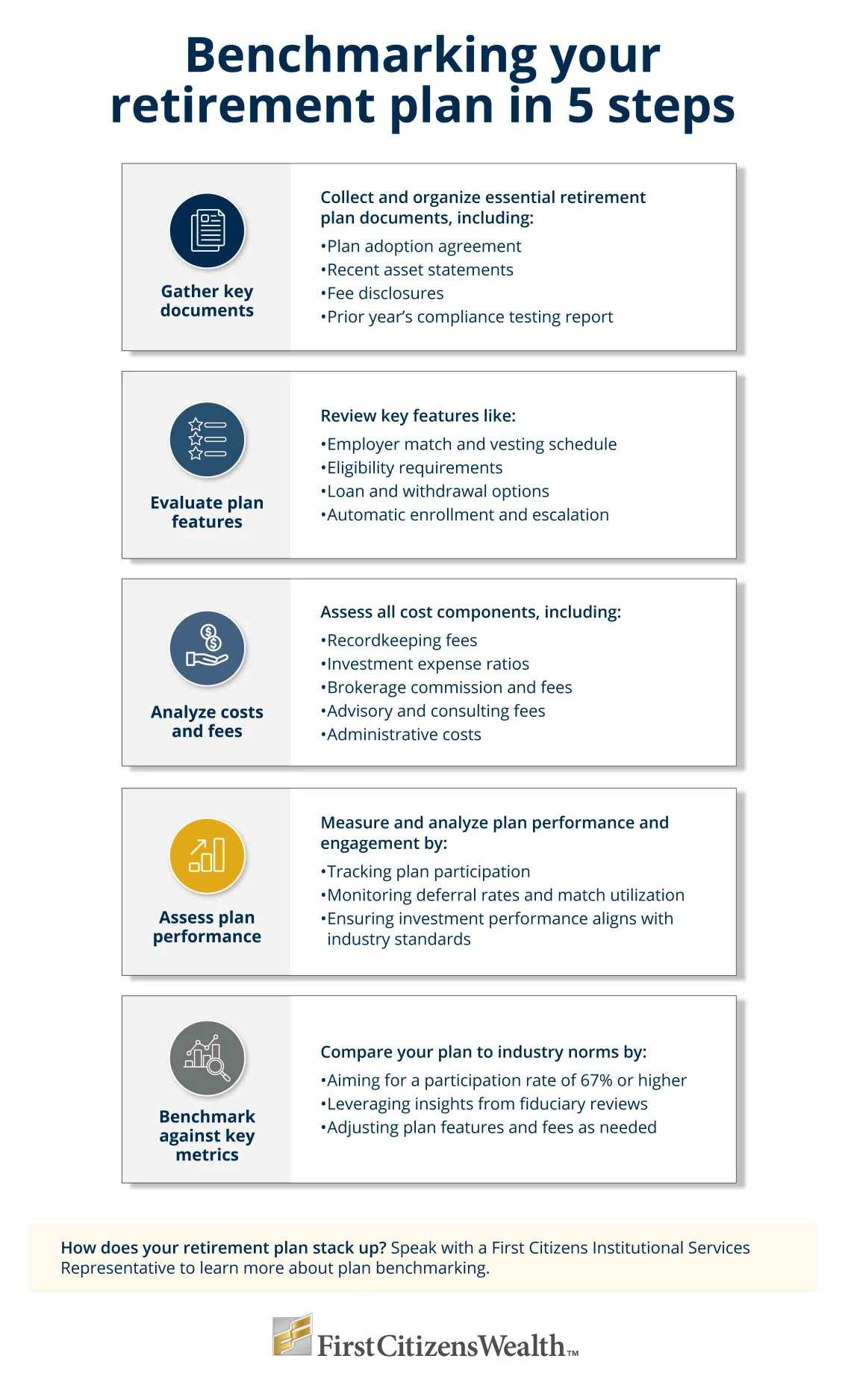Digital banking for business
Seamlessly access all of your accounts from one place with First Citizens Digital Banking for business.
Employers have a fiduciary duty to ensure their retirement plans are competitive, cost-effective and in compliance with changing regulations. Without regular retirement plan benchmarking, organizations may be missing opportunities to reduce fees, address key regulatory updates and align their plan with industry standards.

While periodic reviews are key to achieving these goals, 34% of organizations aren't benchmarking their retirement plans as often as they should.
Retirement plan benchmarking—the process of carefully analyzing and assessing a plan's services and fees against key industry metrics—is an essential step for employers.
The benchmarking process enables organizations to:
A thorough process gives employers the insights needed to strengthen their plans and better support employees. The following sections explore the goals above in detail—including why they matter and how benchmarking can help achieve them.
"Retirement plans don't come up for renewal every year like health insurance," says Chris Bettis, Institutional Business Development Officer at First Citizens. As a result, retirement plans can sometimes remain unchanged for years, exposing businesses to hidden costs, higher fees and outdated structures.
"If you're not benchmarking, you're likely leaving value on the table," he explains. "Your plan may be too expensive for its size, or you may be operating with a plan document that's out of compliance due to recent legislative changes."
Retirement plan costs are distributed across multiple providers from advisors to recordkeepers—making it difficult for employers to understand exactly where their money is going.
"Retirement plan fees are notoriously complex," explains Emily Jones, Institutional Business Development Officer at First Citizens. She emphasizes that benchmarking is a critical tool for bringing clarity and helping employers identify cost-saving opportunities, improve efficiency and evaluate investment expense ratios. Additionally, benchmarking enhances transparency by revealing fees associated with a broker's research, software and other tools—often bundled as soft-dollar revenue within brokerage commissions.
"When we benchmark fees, we take an educational approach," she says. "We help employers understand what they're paying for and which fees are going to which providers."
In addition to controlling costs, benchmarking 401(k) plans can also enable employers to understand value. "You don't need the cheapest plan, but you do need to know whether you're getting the right value for what you're paying," Bettis says.
Employers have a responsibility to ensure their retirement plans remain in compliance with new regulations. Legislative updates—such as those introduced by SECURE Act 2.0—often require plan adjustments. Proactive benchmarking enables employers to identify gaps quickly, reducing the risk of costly penalties or operational disruptions.
"The IRS typically increases 401(k) contribution limits each year," Bettis says. "If you haven't been conducting periodic reviews, you risk noncompliance or potential exposure during a Department of Labor audit."
Retirement plan benchmarking isn't just about cost and compliance—it's also about improving employee engagement and retention. A thoughtful plan design with a strong employer match can help organizations stand out in a competitive talent market.
"If a company isn't matching as much as competitor firms, it can affect employee retention and hiring," Bettis notes. Benchmarking 401(k) plans can help ensure that a retirement plan's structure, investment options and employer contributions remain competitive.
"Retirement plan benchmarking helps you identify what's working and what isn't," Jones says. "Adjusting plan design based on benchmarking insights can increase employee participation and improve overall plan performance."
The process can uncover gaps in participation and contribution rates, helping employers adjust key features like automatic enrollment or employer match to drive better savings outcomes.

Strategic benchmarking isn't just a regulatory requirement—it's a powerful tool for strengthening your retirement plan, improving employee engagement and driving long-term business success.
While the Department of Labor advises employers to benchmark their retirement plans every 3 to 5 years, both Bettis and Jones recommend doing it more frequently. The process becomes particularly important following legislative changes or significant shifts in business structure.
"We benchmark annually for our clients," Jones says. "It's the best way to ensure the plan is performing as intended and that participants are getting the most from it."
Email Us
Please select the option that best matches your needs.
Customers with account-related questions who aren't enrolled in Digital Banking or who would prefer to talk with someone can call us directly.